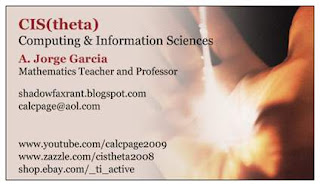
Dear Students,
Yay! We survived our second week on Partial Derivatives. You found TEST2C a bit more challenging than our first test. However, most of you still scored very well. Good job, keep up the good work!
Here's a brief summary of what we covered:
MULTIVARIATE CALCULUS LECTURES
Partial Derivatives: Traces & Level Curves
Optimization & Least Squres Regression
Gradients & LaGrange Multipliers
ELEMENTARY CALCULUS REVIEW FILKS
Quotient Rule
Chain Rule
s(t) vs v(t) vs a(t)
Hope you found that helpful!
Well, that's all folks!
Be well,
A. Jorge García
Applied Math, Physics & CompSci
Nassau Community College (1993-)
http://shadowfaxrant.blogspot.com
http://www.youtube.com/calcpage2009
Baldwin High Retired (1984-2020):
Computing Independent Study Facilitator
Continental Mathematics League Advisor
Baldwin High Chess Club Founder
Baldwin High Chess Team Coach:
US Chess Federation Affiliate
National CompSci Honor Society Advisor:
Grace Hopper NY Chapter
2017 PAEMST NYS Secondary Math Nominee:
HTH,
www.patreon.com/calcpage2020
https://www.udemy.com/user/alvar-garcia-fernandez
https://www.ebay.com/usr/sffbclub

2017 NYS Secondary Math PAEMST Nominee

pastebin youtube slideshare
MATH 4H, AP CALC, CSH: SAGECELL
RECOMMENDED AP COMPSCI REVIEW:
FREE TEXTBOOKS
REVIEW BARRONS ONLINE
REVIEW APCENTRAL (exam format)
REVIEW EDX REVIEW MOOC01
====================
